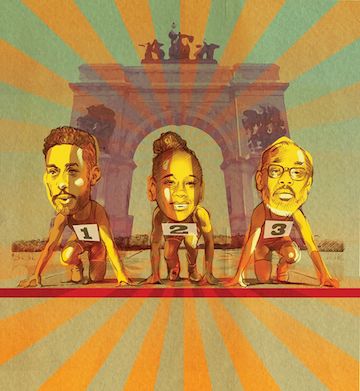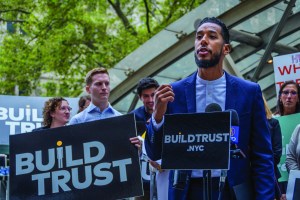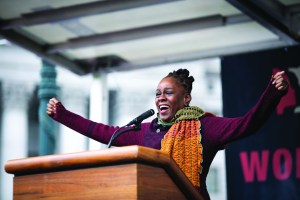The Race for Brooklyn Borough President Heats Up
The likely contenders for borough president have choice things to say about gentrification and real estate
By Aaron Short February 26, 2020 9:00 am
reprints
The year had barely begun when Brooklyn Borough President Eric Adams unexpectedly fired a warning shot above all candidates running for citywide office in the coming months.
Speaking to an audience at a Martin Luther King Jr. Day celebration in Harlem, the mayoral hopeful had some advice for many of the city’s newcomers whose influx has spurred new development and rising rents for native New Yorkers.
“Go back to Iowa; you go back to Ohio. New York City belongs to the people that [were] here and made New York City what it is,” Adams said to a crowd of about 300 people. “You were here before Starbucks. You were here before others came and decided they wanted to be part of this city.”
The Beep’s remarks sparked an immediate backlash from political rivals and many think pieces about who gets to call themselves a New Yorker. Adams himself felt the need to mollify the uproar, tweeting that he wants the city’s newer residents to respect and acknowledge the communities that existed before their arrival by “patronizing local businesses,” or “adopting a local school or shelter and lending a hand.”
That’s a far cry from the Brooklyn booster role Marty Markowitz, Adams’ predecessor, embraced as the borough’s top elected official (and unofficial cheerleader) for a dozen years.
Markowitz, with a heavy assist from the Bloomberg administration, recruited companies to move their headquarters to Downtown Brooklyn and ushered in rezonings there and along the Williamsburg waterfront. He courted developers to build housing and office space and lured professional sports teams like the Nets and Islanders to the Barclays Center. And he celebrated Brooklyn’s creative industries and traveled around the world to promote the borough’s brand of cool.
It worked. Two decades later, Brooklyn has become synonymous around the world as a hipster haven to both the delight and detriment of many. But Adams’ gentrification dispute reveals the tricky landscape those vying to replace him must traverse.
Survivors of the borough’s blackouts and superstorms warily eye wealthier residents who live walled-off lives in luxury condos. And Brooklyn’s newer dwellers feel they have as much of a stake in their neighborhoods as longtime residents and plan to vote in high numbers. There’s been a 32 percent increase in the number of registered Democrats in Brooklyn since 2001, according to state board of election figures.
“Anybody running for local office is going to face that dilemma, trying to appeal to that native New Yorker and those that are new to New York City,” Brooklyn political consultant Lupe Todd told CO. “You really have to be able to let everybody under the Brooklyn tent and voice their opinion and find balance.”
One constituency that may find themselves outside that tent is the real estate industry. Adams ironically has raised a quarter of a million dollars from developers and non-city residents, as the Daily News reported, but few other candidates will tout their ties to an industry that Democratic primary voters view as a scourge and a primary cause of gentrification.
“Candidates are coming out and getting press for saying they’re not taking real estate money,” one Brooklyn developer who declined to be identified told Commercial Observer. “It comes up as one of a couple of things that voters know about a candidate and are likely to consider.”
But that won’t stop the industry from looking at their choices and picking the lesser of three — or six — evils.
“In the kind of brawling ‘not in my backyard’ environment, the office has an important role,” the developer added. “Between the borough president’s role in land use and setting the agenda and populating community boards, that’s a potential opportunity. But the tools at real estate disposal are pretty severely limited this time around, which is not good.”
Whoever gets elected will potentially handle three contentious neighborhood rezonings in Bushwick, Gowanus, and Industry City, as well as the extensive repairs of the Brooklyn Queens Expressway (see story on page 27), rehabilitation of NYCHA properties, revamping of the Brooklyn MTA bus map, ferry terminal expansion, and the continued development of housing around Pacific Park, River Park, the Domino Sugar site, and Greenpoint Landing.
Borough hopefuls have another 19 months to figure it out although fundraising has already begun in order to qualify for the city’s generous 8-to-1 matching program. The last chance to get on the ballot isn’t until next April, before the June primary which is the de facto election date, since Democrats far outnumber Republicans in the borough. The next borough president starts work along with a new mayor on January 1, 2022. So far, only Brooklyn Council members Robert Cornegy and Antonio Reynoso, and Crown Heights activist Lamor Whitehead-Miller have announced for the gig, while Bushwick Councilman Rafael Espinal already dropped out. But other candidates are circling, including New York’s First Lady Chirlane McCray.
Robert Cornegy
The Bedford Stuyvesant Councilman declared for the borough president’s race early — 33 months before the primary — saying he learned from his experience running for City Council Speaker in 2017.
Cornegy narrowly won his Council race in 2013 and sought to run for Speaker four years later with the backing of the Kings County Democratic Party. But he was the runner-up to Corey Johnson, who started campaigning two years before the Council vote and locked up much of the vote before Cornegy could make his case.
Cornegy has plenty of time now to lay out his vision for Brooklyn’s future development. His priorities include ending displacement of longtime residents, promoting economic inclusion, and easing congestion and overcrowding throughout the borough.
“Developers and the city must work in partnership with community boards and neighborhood residents to fully consider their concerns and needs,” Cornegy told CO. “As a city, we can only grow smartly when we ensure that community voices are not only heard but acted on. That’s the path forward that I will promote.”

Cornegy hasn’t dealt with many rezonings in his district. The Council adopted Bedford Stuyvesant North in 2012, a year before he won his seat and the rezoning fight over the city’s plan for 1,900 affordable units in the Broadway Triangle has been fought outside the Council’s purview over the past decade, first in court, according to AMNY, and then among a consortium of nonprofits, as per Curbed.
But Cornegy has run the Council’s Housing and Buildings Committee in which he has pushed for the city Department of Buildings to use drones to inspect facades and funded an expansion of legal services for Bedford Stuyvesant residents, AMNY reported.
It has also put him in closer contact with Brooklyn’s real estate community. He has raised $150,926 in campaign contributions from 388 donors. A handful are from the real estate sector, including top donors Carthage Advisor’s Ed Poteat ($3,950) who develops affordable housing, SK Development’s Abe and Scott Shnay ($6,000 from four family members), and TerraCRG’s Ofer Cohen ($1,000), but most industry leaders haven’t weighed into the race yet.
Other candidates from Central Brooklyn may emerge but the six-foot 10-inch Cornegy, who held a Guinness World Record as the globe’s tallest politician, is head and shoulders above his competitors.
“He’s really smart and educated, he’s got a doctorate, and he also came up through the ranks in Bed-Stuy so he knows the inner workings of community boards, which a [borough president] should know,” Todd said.
Antonio Reynoso
The Williamsburg Councilman’s path to Borough Hall cleared up considerably after his friend, Bushwick Councilman Rafael Espinal, bowed out of the race before quitting public office entirely last month.
That leaves Reynoso as the only candidate from North Brooklyn, one of the borough’s fastest-growing voting populations, and a courtside view of simmering tensions between older and newer residents.

“Most people want their history and existence to be acknowledged,” he told CO. “What gentrification does is try to erase that history and start anew without respecting that history. New folks who come in add value and are living a different type of New York than those who were born and raised. And the foundation of bringing that all together is housing.”
Reynoso started campaigning last June and has raised $84,601 from 680 donors who include a mix of attorneys, small business owners, and independent contractors. A majority of donations are under $250 and many are North Brooklyn residents who have followed his career for years.
The Williamsburg native got his start in electoral politics as an aide to then-Councilwoman Diana Reyna and immediately dove headfirst into some of the most contentious land use battles in the borough including the Broadway Triangle, Domino Sugar Factory, and the Greenpoint Hospital site.
As a council member he, along with Espinal, facilitated a community plan to rezone Bushwick. The volunteer effort took five years of meetings and workshops and sought to concentrate development along the neighborhood’s commercial corridors, in contrast to the city’s plan to rezone 300 blocks of Bushwick. But Mayor de Blasio rejected the group’s recommendations and scrapped the Department of City Planning’s proposal in January, bringing the effort to a standstill.
“We want to push the development to the appropriate areas of the district, and they wanted to rezone the manufacturing sites inside the district,” Reynoso said. “We have no problem having a conversation, but we should be getting more affordable housing there. Instead, the city is treating manufacturing zones as opportunity for luxury housing with very little give back.”
Reynoso has big plans for the borough president’s office. He wants to use experiences on multiple land use conversion efforts to push for a comprehensive plan for all of Brooklyn.
“Isolating that development one neighborhood at a time is pitting one neighborhood against the world,” he said. “Let’s have a plan where places like Bay Ridge and Canarsie, that have never seen rezoning, contribute to the growth of city as much as Williamsburg and Bushwick. The burden of bailing out the city related to housing is falling on poor black and brown communities.”
Reynoso also wants to bulk up the borough’s planning office with more staff and use the bully pulpit of the office to weigh in on improving transit and easing congestion with a rapid bus line and safe pedestrian intersections on Atlantic Avenue.
“There are several main arteries and we need to think about how we would make them central to how we move around Brooklyn, he said. “Right now, it’s every councilman for themselves and every neighborhood for itself.”
Chirlane McCray
The mayor’s political career may be coming to an end next year, but the city first lady’s might just be getting started.
McCray has made no secret of her ambition for higher office once her family leaves Gracie Mansion, and the borough presidency is her likeliest seat.
De Blasio has been quietly pushing her candidacy, even dangling a cross-endorsement to Eric Adams, according to the Daily News. And his top legislative aide was recently hired by the Brooklyn Democratic Party, deepening the relationship between the first family and the party’s new chairwoman Rodneyse Bichotte, paving the way for McCray to secure county support.
McCray, who lived in Park Slope for decades, could simultaneously appeal to voters in central and brownstone Brooklyn, where most of the borough’s Democratic support is concentrated.
And de Blasio is likely to tap his network of donors — many of whom are from the real estate industry who have given to his presidential campaign and political nonprofit groups — to help his spouse’s cause although his leverage over donors and organized labor has diminished.
“Chirlane throws a monkey wrench in for any of those other candidates, but the mayor has no friends,” said one Democratic consultant who isn’t working with anyone in the race. “I don’t think anyone is bending backwards to help Chirlane. He’s a lame duck; he’s out of office by the time that person takes over.”
Her stance on housing and land-use policy is not as well known as her views on health care and the arts. Mental health remains her signature issue, although her $850 million ThriveNYC initiative, which she has led since 2015, has come under heavy criticism from budget watchdogs and council members for its questionable effectiveness.
In the meantime, McCray has already stepped up her presence in Brooklyn. She announced plans to lead a mental health initiative for new parents on a new mental health podcast with BRIC President Kristina Newman-Scott at the nonprofit arts organization’s Fulton Street headquarters. The $9 million initiative will exist separately from ThriveNYC.

Once she gets on the campaign trail, McCray will find she will have to answer for the mayor’s unpopular rezoning efforts in multiple communities while authoring a vision of Brooklyn’s future. (McCray could not be reached by press time.)
And other potential candidates — such as Brooklyn Assemblywoman Jo Anne Simon — could be waiting as well.
“I would be very surprised to see if a state legislator, especially a person of color, did not start looking at that race very soon,” the consultant said.
Update: This story mistakenly said that the date of the primary was September, not June the actual date.



